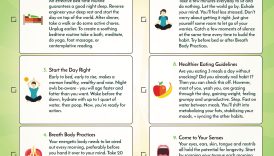Mindful Living: How to Kickstart a Healthier Lifestyle

Introduction to Mindful Living
What is Mindful Living?
Mindful living is a way of life that emphasizes being present and fully engaged in the moment. It involves cultivating awareness of one’s thoughts, feelings, and surroundings without judgment. For many, this can start with simple activities such as mindful breathing, where one takes a moment to focus solely on their breath. Imagine sitting quietly, feeling your breath move in and out, allowing distractions to fade away. This practice can transform ordinary moments into profound experiences of clarity and calmness.
- Mindful Living: How to Kickstart a Healthier Lifestyle
- Introduction to Mindful Living
- What is Mindful Living?
- Benefits of Adopting a Mindful Lifestyle
- Practicing Mindfulness Daily
- Tips for Incorporating Mindfulness Into Your Routine
- Mindful Eating Habits: A Key Component of Healthy Living
- Creating a Mindful Environment
- Decluttering for a Clear Mind
- Importance of a Calm and Peaceful Space
- Mindful Movement and Exercise
- Finding Joy in Physical Activity
- Mind-Body Connection in Fitness
- Nurturing Mental Wellbeing
- Stress-Reduction Techniques
- Cultivating Positive Thoughts and Emotions
- Mindful Relationships
- Building Healthy Connections
- Effective Communication and Active Listening
- Incorporating Mindfulness into Self-Care
- Importance of Self-Compassion
- Setting Boundaries for a Balanced Life
Benefits of Adopting a Mindful Lifestyle
The benefits of adopting a mindful lifestyle are numerous, enhancing both mental and physical wellbeing. By integrating mindfulness into everyday routines, individuals can experience:
- Reduced Stress: Mindfulness can lower stress levels, helping individuals manage anxiety more effectively.
- Improved Focus: When one practices being present, it leads to enhanced concentration and productivity.
- Emotional Regulation: Mindful living can foster better emotional stability, allowing individuals to respond thoughtfully rather than react impulsively.
- Enhanced Relationships: By promoting active listening and empathy, mindfulness contributes to healthier interpersonal connections.
In my own journey, practicing mindfulness has led to moments of clarity during chaotic days, transforming challenges into opportunities for growth. Embracing mindful living can truly lead to a more fulfilling life, fostering inner peace and resilience.
Practicing Mindfulness Daily
Tips for Incorporating Mindfulness Into Your Routine
Integrating mindfulness into your daily routine doesn’t have to be overwhelming. With just a few simple tips, anyone can cultivate a more mindful lifestyle. It starts small, often with intentional moments throughout the day. Here are some practical suggestions:
- Start Your Day with Intention: Before diving into the daily hustle, take a few minutes each morning to set your intentions. This could include practicing gratitude or simply savoring a cup of coffee mindfully.
- Mindful Transitions: Use transitions, like commuting or waiting in line, to practice mindfulness. Focus on your breath or observe your surroundings without judgment.
- Breathing Exercises: Schedule short breaks for deep breathing throughout your day. Even a minute of focused breathing can help recenter your mind.
In my experience, these small changes have led to significant shifts in my day-to-day perspective, allowing me to handle stress more effectively.
Mindful Eating Habits: A Key Component of Healthy Living
Mindful eating is another pivotal aspect of a mindful lifestyle. It involves being fully present during meals, turning eating into a sensory experience rather than a rushed activity. Here are some helpful practices:
- Savor Your Food: Take time to taste and appreciate each bite, noticing flavors and textures.
- Eliminate Distractions: Set aside devices to focus solely on your meal, encouraging a deeper connection with your food.
- Listen to Your Body: Pay attention to hunger cues, ensuring you only eat when truly hungry.
By turning mealtime into a mindful practice, I’ve found greater joy and satisfaction in my food, along with improved digestion and healthier eating habits. Mindful eating can be a transformative journey toward better physical and mental health.
Creating a Mindful Environment
Decluttering for a Clear Mind
A cluttered space often leads to a cluttered mind. Embracing mindfulness in your environment starts with decluttering. Reducing physical clutter not only clears your surroundings but also promotes mental clarity. Here are some effective strategies to achieve this:
- Start Small: Tackle one area at a time, such as a single shelf or drawer. This makes the process less overwhelming.
- The 30-Second Rule: If an item doesn’t spark joy or serve a purpose, consider letting it go. This simple rule can help make decisions easier.
- Create a Donation Box: Keep a box handy for items you no longer need. Regularly donate these items to give them a second life.
In my own journey, clearing my workspace revealed a significant uplift in my focus and productivity.
Importance of a Calm and Peaceful Space
Beyond decluttering, creating a calm and peaceful space is essential for fostering mindfulness. Here are some elements to consider:
- Natural Light: Maximize sunlight to create a warm ambiance that invites serenity.
- Nature Elements: Incorporate plants or floral arrangements to introduce a soothing, natural element to your space.
- Comfortable Setup: Ensure that your environment encourages relaxation, whether through cozy seating or a designated meditation corner.
By curating a harmonious living space, one can cultivate a nurturing atmosphere that invites tranquility and mindfulness. The environment significantly influences mental states, and investing time into creating a peaceful setting can transform daily life into a more grounded experience.
Mindful Movement and Exercise
Finding Joy in Physical Activity
When it comes to exercise, often, the focus is on achieving certain goals or hitting specific targets. However, incorporating mindfulness into movement can transform physical activity into a joyful experience. Here are some ways to embrace this mindful approach:
- Choose Activities You Love: Engage in exercises that genuinely bring you joy, whether it’s dancing, hiking, or yoga. For example, I’ve found that hiking in nature not only keeps me fit but also lifts my spirits.
- Listen to Your Body: Instead of forcing yourself through a workout, tune into your body’s needs and limitations. Focus on how movement feels, rather than how many calories you burn.
- Mindful Warm-Ups: Before starting an activity, take a few minutes to stretch mindfully. This highlights the mind-body connection and prepares you for a more focused workout.
Mind-Body Connection in Fitness
Cultivating a strong mind-body connection is vital in any fitness journey. It enhances our awareness and improves performance. Here’s how to strengthen this connection:
- Breath Awareness: Focus on your breath throughout your workout, helping you stay grounded and centered.
- Visualize Movement: Before performing an exercise, visualize the movement in your mind. This can help enhance your physical execution and create a deeper connection with what you’re doing.
- Practice Gratitude: Appreciate your body for what it can do, rather than focusing on its appearance. This mindset shifts the focus from criticism to celebration.
In my experience, prioritizing mindfulness in exercise has changed how I view physical activity. Instead of a chore, movement has become a joyful and fulfilling aspect of my daily life. By emphasizing the mind-body connection, one can truly embrace the power of movement and its benefits.
Nurturing Mental Wellbeing
Stress-Reduction Techniques
As we navigate life’s challenges, stress can often feel overwhelming. To nurture mental wellbeing, incorporating effective stress-reduction techniques into daily routines can be transformative. Here are some strategies that have worked wonders for me:
- Mindful Breathing: Take a few moments each day to practice deep breathing. This simple technique helps calm the mind and reduces anxiety. I often close my eyes and take ten deep breaths, focusing solely on the air entering and leaving my body.
- Nature Walks: Spending time outdoors can significantly lower stress levels. I’ve found that a walk in the park not only refreshes my mind but also boosts my mood.
- Progressive Muscle Relaxation: This technique involves tensing and relaxing different muscle groups, promoting physical relaxation and mental clarity. It’s a great practice after a long day.
Cultivating Positive Thoughts and Emotions
In addition to stress reduction, cultivating positive thoughts and emotions plays a crucial role in mental wellbeing. Here’s how to foster positivity:
- Gratitude Journaling: Each evening, jot down three things you’re grateful for. This practice shifts focus from negativity to appreciation.
- Positive Affirmations: Start your day with affirmations that uplift your spirit. Phrases like “I am capable” or “I radiate positivity” can reshape your mindset.
- Surround Yourself with Positivity: Engage with uplifting content, whether books, podcasts, or people who inspire you. I’ve noticed that spending time with positive individuals can have a contagious effect on my mood.
By embracing these techniques, individuals can nurture their mental wellbeing, creating a more positive and peaceful life. The journey toward mental wellness is ongoing, but with intention, it becomes rewarding and fulfilling.
Mindful Relationships
Building Healthy Connections
Nurturing mindful relationships is essential for personal growth and happiness. Healthy connections not only enhance our lives but also contribute to our overall mental wellbeing. Here are a few strategies that can help build and maintain these connections:
- Be Present: When spending time with loved ones, focus on being fully engaged. Put down your phone and make eye contact, showing that you value the moment together. I’ve noticed that when I do this, conversations flow more naturally and feel more authentic.
- Establish Trust: Building trust takes time, and it’s crucial for healthy relationships. Being honest and open encourages vulnerability, fostering deeper connections.
- Shared Experiences: Create lasting bonds through shared activities. Whether it’s cooking a meal together, hiking, or simply enjoying a movie night, engaging in meaningful experiences strengthens relationships.
Effective Communication and Active Listening
Effective communication is vital for maintaining mindful relationships. One aspect that often gets overlooked is active listening. Here’s how to enhance your communication skills:
- Listen Without Interrupting: Allow the other person to express their thoughts fully before responding. This shows respect and enables deeper understanding.
- Reflect and Clarify: After the speaker has finished, summarize what you heard to confirm mutual understanding. For example, saying “What I hear you saying is…” can help clarify thoughts.
- Ask Open-Ended Questions: Encourage more in-depth conversations by asking questions that require more than just a “yes” or “no” answer.
In my own life, adopting these communication techniques has transformed how I connect with others. Mindful relationships rooted in understanding and respect not only bring joy but also create a supportive environment that fosters personal growth and resilience. By investing in these connections, we can enrich our lives and the lives of those around us.
Incorporating Mindfulness into Self-Care
Importance of Self-Compassion
As we strive to live mindfully, it’s essential to incorporate self-compassion into our self-care routines. Many people tend to be their harshest critics, often overlooking the importance of treating themselves with kindness. Here are some ways to nurture self-compassion:
- Acknowledge Your Imperfections: Understand that it’s natural to make mistakes. Embracing imperfections can create a more accepting mindset. I recall a time I failed to meet a personal goal and instead of chastising myself, I took a moment to reflect on what I learned from the experience.
- Practice Self-Kindness: When things get tough, talk to yourself as you would to a friend. Offer reassurance and encouragement instead of self-criticism.
- Mindful Reflection: Set aside time for self-reflection through journaling or meditation. This practice allows you to process emotions and cultivate a deeper understanding of yourself.
Setting Boundaries for a Balanced Life
Alongside self-compassion, establishing healthy boundaries is crucial for a balanced life. Boundaries protect your mental and emotional wellbeing, allowing you to prioritize self-care. Here are some tips for setting effective boundaries:
- Know Your Limits: Recognize what you can handle and communicate these limits to others. This clarity fosters respect in relationships.
- Learn to Say No: It’s okay to decline requests that overwhelm you. Politely declining preserves your energy for what truly matters.
- Carve Out Personal Time: Dedicate specific time slots for yourself each week. Use this time for relaxation or pursuing hobbies that bring you joy.
Embracing self-compassion and establishing boundaries has made a significant difference in my life. These practices allow for a more balanced and fulfilling existence, reinforcing the importance of caring for oneself in a mindful way. By prioritizing these elements, individuals can cultivate greater resilience and emotional health.





